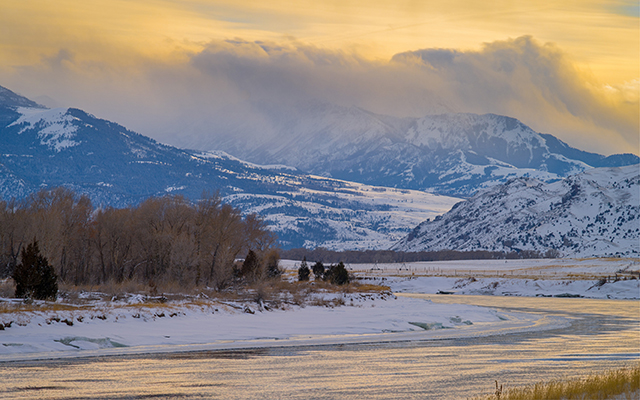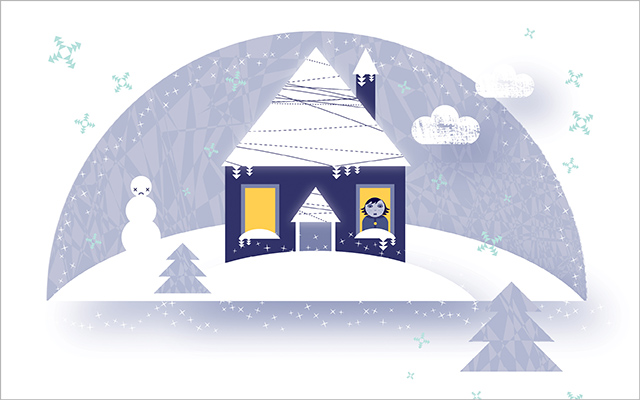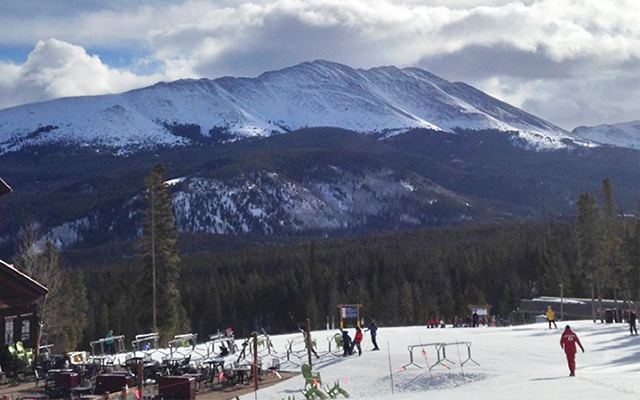Yellowstone National Park. Just the mention of it conjures images of spectacular geysers, wide-open spaces and howling wolves. A photographer’s paradise, people say. The crown jewel of the national park system.
Yet most visitors only see Yellowstone in the summertime – alongside hordes of other tourists. In 2005, of the park’s 2.8 million annual tourists, a whopping 97 percent visited between the relatively warm-weather months of April and October.
Some outdoor-adventure travelers contend, however, that if you think you’ve seen Yellowstone based on your summer RV trip, you’d better think again. Between November and March, they say, a whole different park emerges, one without lines of traffic or crowded campgrounds. One where glistening snowfields stretch as far as you can see, where icicles clinging to stark trees stand in stunning contrast to steaming hot springs, and where the air is so still that merely breathing seems too loud.
In this Yellowstone, elk, bison and moose, in perpetual search of their next meal, travel openly through whitewashed valleys and congregate near hydrothermal pools. Their predators – the elusive mountain lion and the majestic gray wolf among them – are never far behind. And for the hardy souls who visit during winter (fewer than 89,000 during the 2005– 2006 season), the whole show is theirs for the viewing.
“It’s just absolutely gorgeous,” says Katie Fellows, of Hudson, N.H., who visited the park in February 2004 with her husband, Jeff, and sons, Aaron and Matthew. They participated in the Yellowstone Association Institute’s five-day “Winter in Wonderland” program (see “A Study in Nature“). During their cross-country ski outings, they saw nearly a dozen species of animals in their natural habitats and explored hot springs and geysers. “We felt like it was all ours,” adds Fellows.
Navigating the Terrain
Only one road in the 2.2 million–acre park remains open to automobiles during the winter. It runs between the north entrance of the park at Gardiner, Mont., to the northeast entrance at Silver Gate and Cooke City. All other transportation to popular spots – such as Old Faithful, Yellowstone Lake and the Grand Canyon of the Yellowstone River – is by ski, snowshoe, snowcoach (a kind of van with snow treads) or snowmobile tour.
In November 2004, after years of controversy, a ruling to ban snowmobiles in the park during the winter 2004–2005 season was lifted, much to the dismay of silent-sports enthusiasts, environmentalists and other opponents of the vehicles. The park has since put in place a temporary plan that allows entry to a maximum of 720 snowmobiles per day. These must all be assigned to commercial tours and must meet Best Available Technology (BAT) standards for reducing noise and air pollution. This policy is in effect through winter 2006–2007, at which point it may change.
Meanwhile, skis remain the most popular mode of human-powered transportation in Yellowstone. Whether you are a novice or an advanced backcountry skier, miles of maintained trails and acres of pristine wilderness provide first-rate cross-country skiing for all levels.
Jennifer and Brad Bennett, of Missoula, Mont., began visiting the park in 1993 and find it particularly enchanting in winter. “Last winter we took a late-night ski under the full moon. Old Faithful was erupting, and no one was there,” says Jennifer. “It was like something out of a book – so quiet and amazing. It’s almost like a religious experience for us, being in Yellowstone.”
This winter, the Bennetts plan to take a “Yellowstone on Skis” tour offered through the Yellowstone Association Institute. Other visitors prefer to leave the trail and guides behind and head into the backcountry on their own.
For Brook Detterman, of Portland, Ore., a six-day backcountry skiing-and-camping trip offered beauty and challenge. Detterman and a friend chose a southwestern route known for its hydrothermal features, including Lone Star Geyser and numerous hot springs and pools rich with algae. They came across bison and elk, and saw the prints of other animals. At night, they listened to wolves calling out to each other across the miles.
But Yellowstone in winter is not all open ski fields and rare-animal sightings. The park experiences some of the coldest weather in the United States, and winter storms can be ferocious. On the third night of their excursion, a surprise cold front and snowfall caught Detterman and his friend off-guard. “It was probably 20 to 30 degrees below at night,” he says. “It was too cold for our GPS to work.” They built snow caves and hunkered down. Over the next few days they found themselves at times skiing through chest-deep snow and decided to cut their route short. While Detterman enjoyed his trip, the backcountry of Yellowstone, he says, “is not a place for a novice.”
Natural Selection
Facing a Yellowstone winter’s unadulterated challenges and beauty is exactly what many of its adventurous fans love most. People come to Yellowstone during the winter months because they want to experience nature for nature’s sake, in all her cold, frozen and unbridled splendor – and precisely when she can be least friendly to casual sightseers.
“The most magical time of the season may be right around Thanksgiving,” says Bill McKibben, renowned environmentalist, avid cross-country skier and author of The End of Nature (Random House, reprint edition 2006). “Snow has begun to fall, but the park isn’t yet open to snowmobiles…. You see the animals not as part of a crowd parked at the side of the road, but as snorting, surviving wildlife; the geysers are less attractions than a magical fact of life. There’s a sense that it should be a little hard to get to see something this beautiful.”
A little hard, perhaps, but hardly impossible. And if you’re looking for an unforgettable outdoor experience, you’re likely to find winter in Yellowstone well worth the trip.
Go Out & Play
Activities
Cross-country skiing: There are miles of maintained trails throughout the park, leading skiers to the major attractions and offering varying levels of challenge. Leave from lodges or catch a snowcoach to trailheads. Warming huts provide shelter for skiers, snowshoers and snowmobilers. Most are open 24 hours, and some have snacks and drinks available.
Snowshoeing: Snowshoeing is a fun way to explore small areas of the park, and it’s an easy skill to learn, even for beginners.
Ice-skating: Ice-skating is available at both the in-park hotel and lodge.
Education: Free ranger-led programs run from December until March and include educational talks, snowshoe tours and more. Xanterra Parks & Resorts, which operates the park’s lodging and most visitor services, offers activities such as wildlife tours for a fee.
Lodging
Within the park, there are two options for indoor lodging: The Mammoth Hot Springs Hotel, located near the north entrance of the park, and the beautifully restored 1920s-era Old Faithful Snow Lodge and Cabins, in the southwestern quadrant and accessible only via snowcoach. Both are full-service, with restaurants, equipment rentals and even ice-skating rinks. Mammoth Hot Springs Hotel also has hot tubs available. Contact Xanterra Parks & Resorts at 866-439-7375 or 307-344-7311, or visit www.travelyellowstone.com for information about both the hotel and lodge.
Tours
Snowcoach tours serve Mammoth Hot Springs, Old Faithful, and the West Yellowstone and Flagg Ranch information centers, located at the west and south entrances, respectively.|
Trip-Planning Tips
First, you have to decide what kind of trip you want, factoring in the desired activity level and skill of all participants.
- Do you want an all-inclusive trip, where your lodging, meals and activities are taken care of? If so, check out the offerings of the Yellowstone Association Institute’s Lodging & Learning program (see “A Study in Nature“). Program manager Jenny Golding recommends making reservations six months prior to your trip to ensure a spot.
- If you want to stay at one of the in-park accommodations (see “Go Out & Play“) and manage your own itinerary, check availability as soon as you know when you want to travel. Note that during the winter the holidays and President’s Day weekend are the park’s busiest times.
- If you want an unadulterated backcountry experience, make sure that you have the training and proper equipment for your planned excursion. Check the official park Web site (www.nps.gov/yell) for additional tips about planning a backcountry trip. You will also need backcountry camp permits, available at visitor centers and ranger stations.
- If you opt to stay outside the park, numerous area lodges and hotels offer tours into the park, as well as other activities. Check out www.yellowstonepark.com for links to hotels, tour operators and more.
|
A Study in Nature
The Yellowstone Association Institute, a nonprofit field school, is operated in partnership with Yellowstone National Park. It offers 130 educational programs in the winter (400 year-round), which include discounted lodging at the in-park hotel or lodge, all meals and in-park transportation, and educational programming taught by naturalists.
Some popular Lodging & Learning program titles include “Winter in Wonderland,” a five-day introduction to Yellowstone that combines wildlife viewing with cross-country skiing, snowshoeing and snowcoach trips to Old Faithful and the Grand Canyon of the Yellowstone River; and “Winter Wolf Discovery,” a four-day program focused on learning about the majestic and mysterious gray wolf, which was reintroduced to the park in 1995. The institute also offers in-depth field-study programs year-round at the Lamar Buffalo Ranch Field Campus, with rustic cabin lodging and a communal dining yurt. Check out www.yellowstoneassociation.org or call 307-344-2293 for more information.|
Winter Safety Tips
Weather. Daytime temps typically range between zero and 20 degrees Fahrenheit, and can drop below zero at night. There’s always the chance of snow or avalanche. For warmth, layers of synthetic and wool clothing, covered by a nylon shell, are recommended.
Hydrothermal features. There are more than 10,000 hydrothermal features in the park, including geysers, hot springs, pools and steam vents. Water and steam in these areas are scalding. Stay alert when near any known hydrothermal areas – and always watch your footing, as snow and debris may obscure some surface features.
Altitude. Most of the park is between 5,300 and 8,900 feet above sea level. Make sure you take time to acclimate before engaging in any strenuous activity. And take care to stay properly hydrated.
Animals. Wild animals abound in Yellowstone, including bears, elk, bison, deer, moose, bighorn sheep, coyotes, wolves and mountain lions. They are more visible during the winter months, when they’re searching out scarce food sources. Never approach an animal, and always keep a safe distance of at least 25 yards from wildlife.




This Post Has 0 Comments